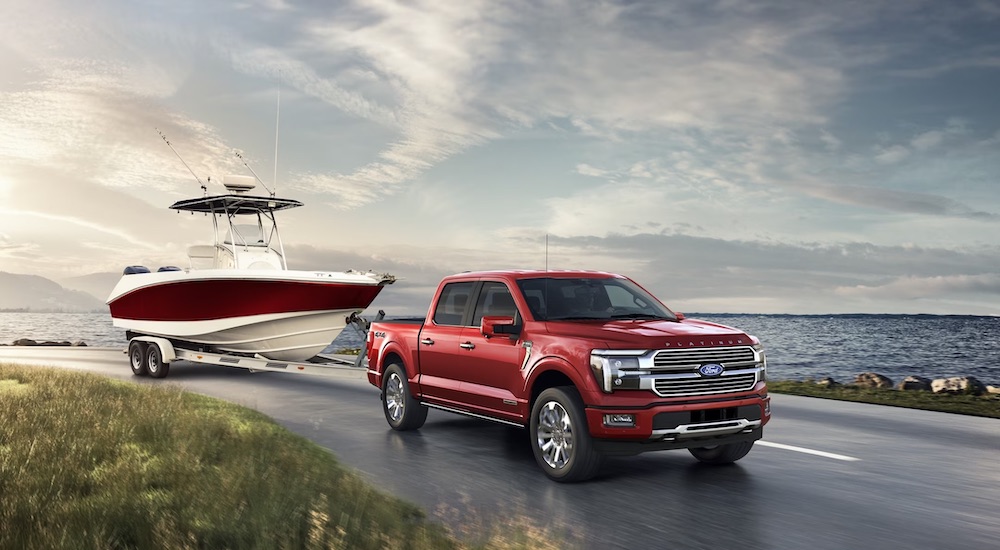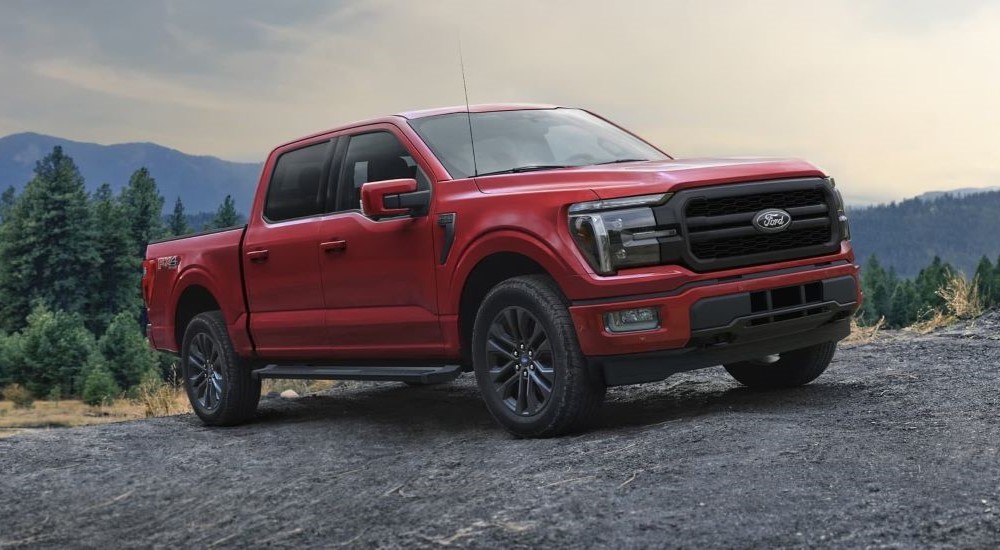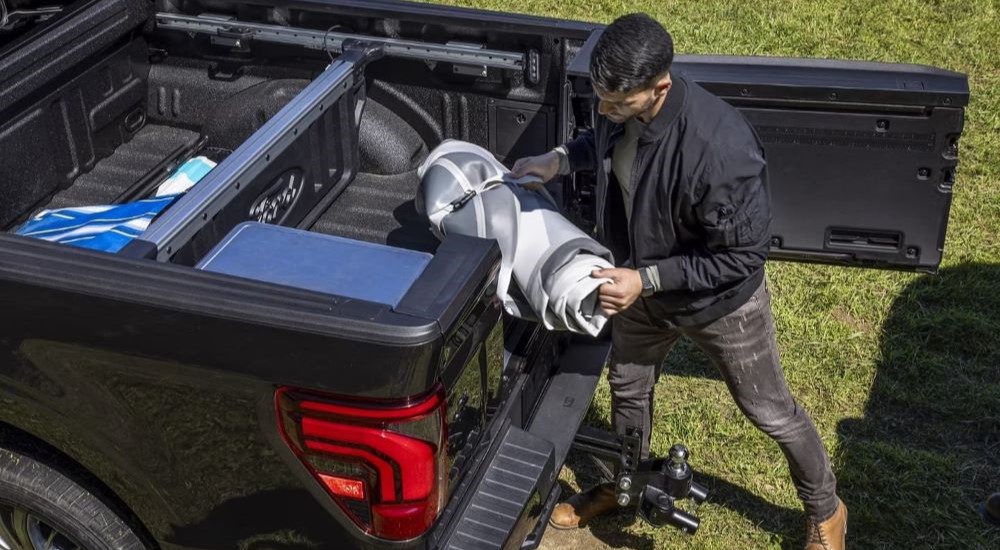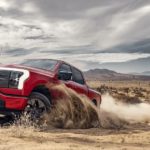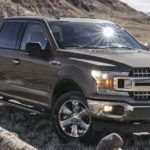When you need to get down to business, it helps to have a good truck in your corner. But what exactly that business is can be an important factor in customizing your truck. Take the 2024 Ford F-150: it can be had in a variety of different trim levels and with various combinations of cab styles and box sizes. If you’re rolling out to a worksite and need to haul long planks of lumber and bring along a crew of fellow workers, you’ll probably want a different configuration than someone who’s a solo delivery driver navigating tight city streets.
One of the most important choices you have to make when customizing an F-150, perhaps the most important choice, is which powertrain you’re going to get. The 2024 model dropped a few options from the 2023 lineup, including the diesel-powered engine, but there are still plenty of different choices for truck buyers browsing their local Ford dealer. Today, we’re going to focus on four that are especially good for taking care of business, leaving out the high-output engines that power the Raptor and Raptor R, which are great for getting your kicks off-road but not so practical when getting down to brass tacks at your worksite.
1. Now Standard: 2.7L EcoBoost V6
For the 2023 model year, the base engine on the F-150 was a 3.3L TI-VCT V6 that delivered 290 hp and 265 lb-ft of torque. That engine is no longer available for 2024, making the 2.7L EcoBoost V6 the new base option. Since it displaced fewer liters, you might expect it to be a less powerful engine, but that’s not the case here. This V6 can deliver slightly more hp at 325 hp and considerably more torque at 400 lb-ft thanks to its direct-injection system, dual overhead cam design, and twin turbochargers. Horsepower is great for getting up to highway speeds, but torque is the key player in determining towing capacity, so having a higher figure goes a long way for hard workers.
The new base engine is also more efficient than the outgoing standard option. The 3.3L had EPA-rated fuel economy ratings of 19 MPG in the city and 24 MPG on the highway, while the 2.7L engine gets 20 MPG on city streets and 26 MPG for highway drives. While power is often the most important consideration for a work truck, efficiency can be a big help, too, cutting down on extra time spent at gas stations so you can get home sooner and making it so you don’t have to spend as much of your hard-earned money on filling up the tank.
If you’re looking to bring some power directly to your worksite so you can operate power tools anywhere you go, you can use the optional Pro Power Onboard feature, which is available on the 2.7L powertrain. The 2.0-kilowatt system that pairs with this engine, as well as the 3.5L EcoBoost V6 and the 5.0L V8, adds two 120V 20A outlets to the bed. That’s enough to power saws, drills, battery chargers, and more. You can also use it to improve your worksite with things like portable speakers, electric heaters, or even a mini-fridge or TV to keep you up on the scores during breaks.
2. Increased Power: 5.0L TI-VCT V8
If you crave a V8, then the 5.0L TI-VCT V8 powertrain is available to deliver 400 hp and 410 lb-ft of torque. That kind of power lets you tow and haul more weight than the base engine can handle, so you can tackle bigger jobs without worrying about compromising your safety or wearing down your truck. That power does come with a drawback in terms of fuel economy, with 16 MPG in the city and 25 MPG on the highway, the V8 is the least efficient option outside of the high-output powertrains offered on the Raptor. But if you want that classic V8 rumble, then that’s a small price to pay.
3. Highest Towing & Hauling Capacity Available: 3.5L EcoBoost V6
Though the V8 option has plenty of power, it’s actually not the most powerful option in the lineup. The 3.5L EcoBoost V6 matches the V8’s maximum hp output exactly with 400 hp and delivers even more torque at 500 lb-ft. With this powertrain, you can unlock the F-150’s maximum towing capacity of 13,500 lbs and its maximum payload capacity of 2,445 lbs, giving you plenty of room to take on big jobs where heavy equipment needs to be delivered on a trailer or lots of weighty cargo needs to be loaded into the bed, from large pieces of lumber to stacks of concrete bricks. Rated at 18 MPG in the city and 24 MPG on the highway, the 3.5L V6 is slightly more efficient than the V8, so you get that extra power without having to pay any more at the pump.
The 3.5L V6 comes standard on the King Ranch and Platinum trims, which also offer additional creature comforts that can make driving home more pleasant after a hard day’s work. Heated and ventilated seats help you beat the heat during summer lunch breaks or warm up quickly on early morning commutes, and a premium Bang and Olufsen sound system lets you pump yourself up before a tough job with your favorite music. These trims also have unique styling touches that help drivers take pride in their truck.
4. Efficient, Surprisingly Powerful, & Useful On-Site: 3.5L PowerBoost Full Hybrid V6
Hard-working truck owners aren’t exactly the key demographic for hybrid vehicles, traditionally speaking. But as electric motor technology has evolved, it’s become capable of a lot more than just reducing the number of times you need to stop at the gas station. Sure, the hybrid powertrain does offer improved fuel economy, getting 25 MPG on both city streets and highways, but that’s not the only benefit that it has up its sleeve.
The hybrid powertrain pairs the 3.5L V6 engine with an electric motor, bringing the total system’s stats up to 430 hp and 570 lb-ft of torque. And electric power delivers torque almost instantly, reaching its peak potential at much lower speeds than internal combustion engines can. That means that if you’re towing a lot of weight while driving at low speeds, like when parking or navigating a crowded worksite, you’ll get better performance and have an easier time getting around. And you can get that power for the same cost as the 3.5L non-hybrid powertrain since Ford decided to price the two the same for the 2024 model year in order to make the hybrid more accessible.
While the other powertrain options listed here can all be had with a 2.0-kilowatt version of ProPower Onboard, the hybrid powertrain comes standard with a more powerful 2.4-kilowatt version that can run for up to 85 hours on a full tank of gas. This lets you operate more powerful tools on the go, like air compressors, concrete mixers, or even jackhammers. For maximum power, you can upgrade to the 7.2-kilowatt version only if you opt for the PowerBoost powertrain, giving you four outlets in the bed and the capability to accomplish tasks that drain a lot of energy, like welding, even in the most remote worksites.
What you need from a truck engine is as individual as your business is. Hopefully, now you will have an idea of what to look for.
